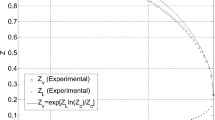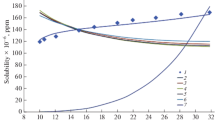Abstract
A new simple equation for prediction of vapor pressure of pure substances is proposed. The equation which has the Clausius-Clapeyron (C-C) equation form consists of three parameters: critical temperature, critical pressure and normal boiling point. Experimental data for organic and inorganic substances have been used to calculate equation parameters in the boiling point ranges from 169.45 to 457.55 K and critical temperature ranges from 282.75 to 699.15 K. Comparison of proposed equation estimation results with experimental data shows that the new equation has minor average error. The new equation is also 68 percent more accurate than the C-C equation
Similar content being viewed by others
References
W. C. Edmister and B. I. Lee, Applied hydrocarbon thermodynamics, Vol. 1, Gulf Publishing Co., Houston (1986).
C. H. Whitson, SPE journal, 685–696 (1984).
K. R. Hall and L. Yarbourough, OGJ, 82–92 (1973).
R. P. Sutton and F. F. Farshad, Evaluation of empirically derived PVT properties for Gulf of Mexico crude oils, SPE Paper 13172, Proceedings of the 59th Annual SPE Technical Conference, Houston (1984).
J. M. Campbell, Gas conditioning and processing, Campbell Petroleum Series, Vol. 1, Norman, Okla. (1960).
T. E. Daubert, Chemical engineering thermodynamics, Chapter Six, Mc.Graw-Hill (1985).
T. E. Daubert and D.K. Jones, Pure component liquid vapor pressure measurements, Project 821, AIChE Symp., Ser. 86, (1990).
M. Reinhard and A. Drefahl, Handbook for estimating physicochemical properties of organic compounds, Wiley & Sons, New York (1999).
H. Nishiumi, H. Akita and S. Akiyama, Korean J. Chem. Eng., 14, 359 (1997).
C. Kwak and T. F. Anderson, Korean J. Chem. Eng., 8, 88 (1991).
E. S. Goll and P.C. Jurs, J. Chem. Inf. Comput. Sci., 39, 1081 (1999).
H.W. Xiang, Int. J. Thermophys, 22 (2001).
W. Wagner, Cryogenics, 13, 470 (1973).
Kh. Mejbri and A. Bellagi, Thermochimica Acta, 436, 140 (2005).
R.C. Reid, J.M. Prausnitz and B. E. Poling, The properties of gases and liquids, fourth ed., McGraw-Hill, 205–240 (1987).
B. E. Poling, J. M. Prausnitz and J. P. O’Connell, The properties of gases and liquids, fifth ed., McGraw-Hill (2001).
P. J. Linstrom and W.G. Mallard (Eds.), NIST chemistry webBook, NIST Standard Reference Database Number 69 (http://webbook.nist.gov) (2001).
H. P. Robert, Perry’s chemical engineers’ handbook, sixth edition, section 3 (1984).
Author information
Authors and Affiliations
Corresponding author
Rights and permissions
About this article
Cite this article
Mohammadzadeh, S., Zahedi, G. A new vapor pressure equation for pure substances. Korean J. Chem. Eng. 25, 1514–1517 (2008). https://doi.org/10.1007/s11814-008-0249-1
Received:
Accepted:
Published:
Issue Date:
DOI: https://doi.org/10.1007/s11814-008-0249-1




